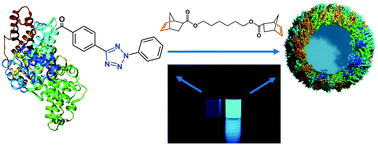Fully degradable protein nanocarriers by orthogonal photoclick tetrazole–ene chemistry for the encapsulation and release†
Abstract
The encapsulation of sensitive drugs into nanocarriers retaining their bioactivity and achieving selective release is a challenging topic in current drug delivery design. Established protocols rely on metal-catalyzed or unspecific reactions to build the (mostly synthetic) vehicles which may inhibit the drug's function. Triggered by light, the mild tetrazole–ene cycloaddition enables us to prepare protein nanocarriers (PNCs) preserving at the same time the bioactivity of the sensitive antitumor and antiviral cargo Resiquimod (R848). This catalyst-free reaction was designed to take place at the interface of aqueous nanodroplets in miniemulsion to produce core–shell PNCs with over 90% encapsulation efficiency and no unwanted drug release over storage for several months. Albumins used herein are major constituents of blood and thus ideal biodegradable natural polymers for the production of such nanocarriers. These protein carriers were taken up by dendritic cells and the intracellular drug release by enzymatic degradation of the protein shell material was proven. Together with the thorough colloidal analysis of the PNCs, their stability in human blood plasma and the detailed protein corona composition, these results underline the high potential of such naturally derived drug delivery vehicles.

- This article is part of the themed collections: Horizons Community Board Themed Collection – Nanobiomedicine and Celebrating Excellence in Research: Women of Materials Science


 Please wait while we load your content...
Please wait while we load your content...